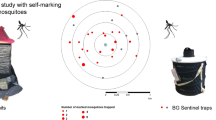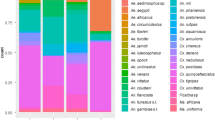Summary
The attraction range of a human bait forAedes albopictus (Diptera, Culicidae) adults and its absolute density in the range were estimated by a new removal method which is applicable to populations with immigrants. In this model, the number of mosquitoes removed during thekth collection unity k, is expressed as
wherex 0 is the initial number of mosquitoes in the attraction range,a is an index directly proportional to collection efficiency,b is the number of immgirants per collection unit ands(=e−a) is the survival rate of mosquitoes in the attraction range per collection unit. From the result of successive two collections with various interval distances, it was considered thatAedes albopictus adults are attracted to a human bait from the distance of 4–5 m in the bamboo forest on the calm day. The applicability of this method for the population census of forest mosquitoes was discussed.
Similar content being viewed by others
References
Bekku, H. (1953) Studies on the diurnal activity of bush-inhabiting mosquito. I.J. Nagasaki Med. Soc. 28: 1027–1035 (in Japanese with English summary).
Bidlingmayer, W. L. andD. G. Hem (1980) The range of visual attraction and the effect of competitive visual attractants upon mosquito (Diptera: Culicidae) flight.Bull. Ent. Res. 70: 321–342.
Brown, A. W. A. (1954) Studies on the responses of the femaleAedes mosquito. Part VI.-The attractiveness of coloured cloths to Canadian species.Bull. Ent. Res. 45: 67–78.
Brown, A. W. A. (1966) The attraction of mosquitoes to hosts.J. Amer. Med. Assoc. 196: 249–252.
Clements, A. N. (1963)The physiology of mosquitoes. Pergamon Press, Oxford.
Gillies, M. T. (1972) Some aspects of mosquito behaviour in relation to the transmission of parasites.Zool. J. Linn. Soc. Lond. (Suppl. No. 1)51: 69–81.
Gillies, M. T. andT. J. Wilkes (1969) A comparison of the range of attraction of animal baits and of carbon dioxide for some West African mosquitoes.Bull. Ent. Res. 59: 441–456.
Gillies, M. T. andT. J. Wilkes (1970) The range of attraction of single baits for some West African mosquitoes.Bull. Ent. Res. 60:225–235.
Gillies, M. T. andT. J. Wilkes (1972) The range of attraction of animal baits and carbon dioxide for mosquitoes. Studies in a freshwater area of West Africa.Bull. Ent. Res. 61: 389–404.
Gillies, M. T. andT. J. Wilkes (1974) The range of attraction of birds as baits for some West African mosquitoes (Diptera, Culicidae).Bull. Ent. Res. 63: 573–581.
Hartberg, W. K. (1971) Observations on the mating behaviour ofAedes aegypti in Nature.Bull. WHO 45: 849–850.
Kalmus, H. andB. Hocking (1960) Behaviour ofAedes mosquitoes in relation to blood-feeding and repellents.Ent. Exp. Appl. 3: 1–26.
Khan, A. A., H. I. Maibach, W. G. Strauss andW. R. Finley (1965) Screening humans for degrees of attractiveness to mosquitoes.J. Econ. Ent. 58: 694–697.
Kahn A. A., H. I. Maibach andW. G. Strauss (1971) A quantitative study of variation in mosquito response and host attractiveness.J. Med. Ent. 8: 41–43.
Kono, T. (1953) On the estimation of insect population by time unit collecting.Res. Popul. Ecol. 2: 85–94 (in Japanese with English summary).
Laarman, J. J. (1955) The host-seeking behaviour of the malaria mosquitoAnopheles maculipennis atroparvus.Acta Leidensia 25: 1–144.
Muirhead-Thompson, R. C. (1951) The distrubition of anopheline mosquito bites among different age groups, s new factor in malaria epidemiology.Br. Med. J. 1: 1114–1117.
Nishimura, M. (1980) Attractive distance of man for mosquitoes.Abstracts of 16th Intern. Congr. Ent. (Kyoto, Japan): 140.
Rahm, U. (1958) Die attractive Wirkung der Menschen abgegebenen Duftstoffe aufAedes aegypti L.Z. Tropenmed. Parasitol. 9: 146–156 (cited fromKhan et al., 1965).
Service, M. W. (1971) The daytime distribution of mosquitoes resting in vegetation.J. Med. Ent. 8: 271–278.
Sinsko, M. J. andG. B. Craig, Jr. (1979) Dynamics of an isolated population ofAedes triseriatus (Diptera: Culicidae) I. Population size.J. Med. Ent. 15: 89–98.
Smart, M. R. andA. W. A. Brown (1956) Studies on the responses of the femaleAedes mosquito. Part VII.-The effect of skin temperature, hue and moisture on the attractiveness of the human hand.Bull. Ent. Res. 47: 89–100.
Author information
Authors and Affiliations
Rights and permissions
About this article
Cite this article
Mogi, M., Yamamura, N. Estimation of the attraction range of a human bait forAedes albopictus (Diptera, culicidae) adults and its absolute density by a new removal method applicable to populations with immigrants. Res Popul Ecol 23, 328–343 (1981). https://doi.org/10.1007/BF02515635
Issue Date:
DOI: https://doi.org/10.1007/BF02515635




